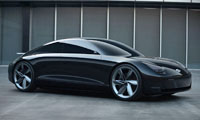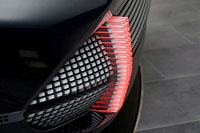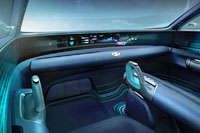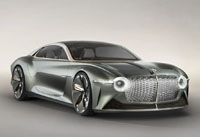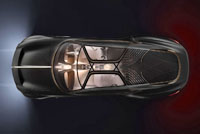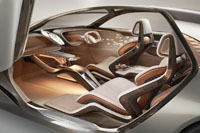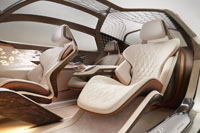
Those fortunate enough to have attended a major auto show (remember those?) will know that some of the most exciting new reveals are concept cars and prototypes, yet for some reason Porsche has hidden away most of its non-production gems, until now that is.
As part of a new “Porsche Unseen” project that includes a hard cover book and website, Porsche dusted off 15 of its previously hidden concepts, showing some that were clearly inspired by the brand’s motorsport success and others that influenced today’s production models. There’s a number of gorgeous modernized historical recreations too, not to mention others that pay tribute to the brand’s previous rally racing triumphs. All were organized into four appropriately named categories, including Hypercars, Little Rebels, Spin Offs, and What’s Next? So without further ado let’s delve into each one in order to see all that Porsche has been hiding from us over the past decade-and-a-half.
Hypercars: Will any of these concepts influence Porsche’s next supercar?
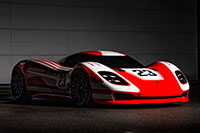
The Hypercars category is by far the largest, incorporating six concepts that’ll easily get your head spinning. The first arrived in 2013 and the most recent was created in 2019, with the result being six glorious years of would-be supercars. Before we start complaining about none in this six-pack getting the green light for production, we should remember the brilliant 918 Spyder that was actually being produced during much of this era. Still, how we’d love to see production runs of some of these others. At the very least, these concepts will inspire future designs, which might have to be good enough.
2013 Porsche 917 Living Legend: Gorgeous race car for the street
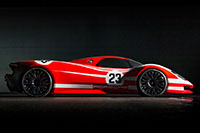
We covered the stunning 917 Living Legend at length previously in these pages, as it was the only car from this collection to see daylight thanks to Porsche’s 50th anniversary “Colours of Speed” exhibition that took place at the brand’s museum in Stuttgart-Zuffenhausen, Germany in 2013. If the name didn’t give it away, its modernized take on the legendary 917 KH race car makes its heritage known immediately.
The famed model was responsible for Porsche’s first Le Mans win (that now total 19) in 1970, so it’s only appropriate that the concept wears a revised version of the original’s Salzburg red-and-white paint scheme. The 1:1 industrial plasticine model fittingly marked Porsche’s return to the top-level LMP1 class of FIA-sanctioned sports car racing.
2015 Porsche 906 Living Legend: Once again pulling inspiration from motorsport
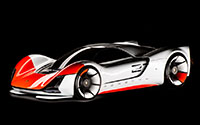
Following a motorsport theme, the 906 Living Legend was heavily inspired by Porsche’s 906 race car that took part in the 1966 Targa Florio road race. Specifically, the 906 Living Legend’s front lighting elements can be seen in the cooling ducts, not unlike those on the original, while its red and white livery references the classic racer too.
“The design process for such visions is very free,” stated Porsche’s Chief Designer, Michael Mauer. “It is not necessary to keep to pre-defined product identity characteristics. For example, the headlights were positioned in an air intake as a futuristic light source. When we were later developing an identity for our electric models, we took another look at these designs. The radical idea of simply integrating a light source in an opening instead of a glass cover seemed appropriate for us. We are now approaching this ideal.” Additionally, Mauer said, “Modern hypercars are greatly dependent on their aerodynamics and openings resulting from the enormous ventilation requirements.”
2017 Porsche 919 Street: From racetrack to perceived public roads with little modification

The 919 Street, created in 2017, is in fact a road-going 919 Hybrid LMP1 race car, in 1:1 clay model form at least. The track-only 919 Hybrid, which laid waste to all LMP1 sports car challengers, achieving four consecutive FIA World Endurance Championships from 2014 to 2017, was an ideal starting point for any road-going hypercar.
Therefore, Porsche kept the basic design of the race car’s bodywork and underpinnings intact, including its carbon-fibre monocoque and 900 PS hybrid drivetrain, not to mention its overall dimensions including its track and wheelbase, which are identical. It’s hard to imagine why Porsche didn’t build this beast, as every example would’ve been snapped up by collectors in minutes.
2019 Porsche Vision 918 RS: This one owes its existence to the 918 Spyder supercar

Porsche was seriously considering producing the 918 RS, however, having moved the concept along all the way to the development stage. As you may have guessed (or read in the title), this 1:1 hard model rides on the backbone of Porsche’s hybrid-powered 918 Spyder, but unlike the ultra-fast roadster this one wears a permanent roof.
The fixed head coupe profile wasn’t the only original bit of bodywork either, with as plenty of other upgrades were made to give the 918 RS its own unique look. Is this the future of Porsche hypercars? Being one of the most recent, we think it provides a hint of what the Stuttgart brand has in store.
2019 Porsche Vision 920: A future LMP1 car?

The Vision 920 is more about looking into the future than the past. Hopefully it’s imagining something track-ready for Porsche’s next foray into sports car racing, as the car looks armed and ready for FIA LMP (Le Mans Prototype) sanctioned events. In true dedicated race car fashion, the solo driver occupies the centre position behind a wraparound jet-fighter like windshield.
Likewise, all the aerodynamic ducting and exposed suspension hardware make this motorsport concept appear like a future series champion, so let’s hope they build it and head back to Le Mans.
2019 Porsche Vision E: Is this Porsche’s future?
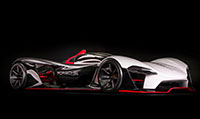
Porsche left sports car prototype racing to focus on the all-electric Formula E series, which is probably why the Vision E concept exists. It’s powered by an 800-volt, fully-electric power unit, although unlike Formula E cars this more road-worthy alternative is fully-enclosed to had its single occupant from the elements.
Tiny motorcycle-like fenders make it kind of legal, theoretically, although being that it was just a 1:1 hard model we’ll never know. Porsche did move it all the way up to the development stage, mind you, but so far nothing similar has shown up in any future model section of the German brand’s website.
Little Rebels: These are the little cuties we know you want most
Few brands pay greater tribute to past triumphs than Porsche, but then again, few brands have such storied pasts to draw upon. The Little Rebels category pulls design elements from a few Porschephile favourites, so make sure to let us know which one you’d like to have in your driveway.
2013 Porsche 904 Living Legend: Autocross star in the making
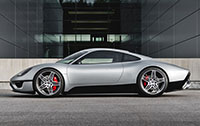
Can we get a vote? Is the 904 Living Legend your favourite so far? It certainly ranks high on our list of cars we’d love to see Porsche build, even if it’s already eight years old. Interestingly, this retrospective sports car was actually based on the VW XL1 streamliner, a fuel-economy-focused diesel-powered (are we allowed to mention that word anymore?) prototype.
Porsche dug into a different VW group brand to source the 904 Living Legend’s engine, however, resulting in a high-revving Ducati V2 motorcycle engine that no doubt has little problem moving this 900-kilgram two-seater like a rocket.
While our fingers are crossed something similar gets created with Porsche’s fabulous turbocharged four-cylinder stuffed into the engine compartment, resulting in a German interpretation of Lotus’ Elise, or more accurately a modernized version of the late great 1963 Porsche Carrera GTS (it’s inspiration after all), we’re not ponying up down payments just yet.
2016 Porsche Vision 916: Beautiful, fast and clean

The Vision 916 might look like supercar, but in reality, the sleek two-seat coupe is a lot more down to earth. In fact, the Vision 916 features a 100-percent electric battery and hub-motor drivetrain, combining for blisteringly quick acceleration and zero emissions.
Porsche says it was inspired by a six-cylinder-powered version of the ‘70s-era 914, dubbed 916, which was never produced for mass consumption, but we can’t see much of a resemblance to the squared off mid-engine model.
2019 Porsche Vision Spyder: Boxster of tomorrow?

The more rectangular Vision Spyder, on the other hand, has 914 written all over it, and we’re hoping it influences the next 718 Boxster. Yes, Porsche’s entry-level roadster still looks great, but every model needs updates, and pushing 718 series design in the Vision Spyder’s direction certainly wouldn’t hurt.
The 1:1 hard model receives a classic silver, red and black motorsport livery that would cause any Porschephile to be hopeful for a potential spec racing series, or at least provide some happy thoughts about future weekends at a local autocross course.
Just like today’s 718 series, this Vision Spyder receives its ideal handling balance from a mid-engine layout, while some styling highlights can be traced back to the 1954 550-1500 RS Spyder. As noted, we’re also eyeing some 1969-1976 914 in this design, particularly in its angular elements and fabulous looking roll hoop.
Spin-Offs: These ones are closer to reality
When you think of spin-offs, what comes to mind? Normally the term conjures up the next Star Wars prequel or sequel, or perhaps another Marvel comic strip coming to life. In Porsche-speak, however, it’s all about modifying an existing model to the nth degree, so that its purpose becomes expanded beyond its original scope.
2012 Porsche 911 Vision Safari: The ultimate rally car?

Those who’ve loved Porsche for multiple decades may remember the phenomenal 959, which when after debuting in 1986 became the fastest production car in the world. Being four-wheel drive, Porsche went about raising and beefing up its suspension in order to take the car rallying, which resulted in immediate first, second and sixth place finishes in the 1986 Paris-Dakar rally—7,500 of the most grueling miles any car could endure.
Seeing something similar based on the even more attractive 991 body style is even better, especially when factoring in that it probably wouldn’t set its buyer back anywhere near the $6 million USD needed to pick up a race-experienced 959.
Of course, this one-off concept would be worth a fair penny if Porsche decided to sell it, but that’s not likely to happen. Instead, they might want to combine an updated version based on the latest 911 Turbo with a spec off-road series. Hey, we can hope.
2013 Macan Vision Safari: Porsche should build this awesome 4×4

While an off-road capable 911 sounds awesome, a 4×4-ready Macan makes more sense from a sales perspective. If that sounds too farfetched to contemplate, stretch your mind back to when the original Cayenne arrived. It was actually quite handy off-road, so we know Porsche isn’t against getting dirty when it needs to.
Despite being based on the first-generation Macan, this Vision Safari concept shows just how amazing a muscled-up version of Porsche’s entry-level SUV could be. Look a little closer and you might notice that this 1:1 scale hard model isn’t only about big tires and bulky body-cladding, it’s also been transformed into a two-door coupe. We’d like it with four doors too, so hurry up and build it, Porsche.
2014 Porsche Boxster Bergspyder: the perfect mid-engine track star

Back on tarmac, Porsche’s 2014 Boxster Bergspyder would be better suited to smooth surfaces than anything unpaved. Based on Porsche’s lightweight roadster, with yet more mass removed via a barchetta-style permanently open roof, the elimination of the passenger seat (two’s a crowd anyway), and substitution of critical components with lighter weight composites, the Bergspyder has track star written all over it.
Additional updates include 911 Speedster-like shorten windscreen pillars along with cool dual roll hoops ahead of a Carrera GT-style double-bubble rear deck lid for a truly exotic look. The cabin’s primary gauge cluster comes straight out of a 918 Spyder, while a useful helmet shelf sits where the passenger would have previously.
If you thought dropping the Boxster’s weight down to a featherlight 1,130-kilos was good news, the inclusion of the Cayman GT4’s high-revving 3.8-litre flat-six is pure icing on the cake.
2016 Porsche Le Mans Living Legend: this is the one we want the most

The Le Mans Living Legend is a Boxster/Cayman-based sports coupe that pulls memories from the ‘50s. Inspired by the stunning 1953 550 Le Mans racing coupe, this one-off boasts a mid-mounted V8 with “excessive sound development,” or so says Porsche. It’s mated to a manual transmission, which is surprising yet ideal, and without doubt would clean up on any competitors that would dare to race it.
The divided rear window is a design element we’d love to see somewhere in Porsche’s future lineup, not to mention the classic exposed fuel cap mounted smack dab in the centre of the hood. Beautiful is an understatement, so let’s hope Porsche has plans to build it.
What’s Next? One that’s already here and another only displaying technology
The Vision Renndienst (Race Service) and Vision Turismo are the only two concepts that fall under the “What’s Next?” menu, but don’t let the name of this category make you think we’re about to be inundated with little electric delivery vans wearing Porsche badging.
2018 Porsche Vision Renndienst: It’s what’s underneath the skin that matters

A Porsche minivan? While this cute little runabout wears Porsche’s famed crest up front (albeit a faded grey version with a transparent background), the Vision Renndienst is more about the all-electric skateboard platform design it sits upon.
Styled after the race service vans used in early racing programs, the Vision Renndienst has accommodations for six occupants, with the driver up front in the middle, either facing forward or rearward for relaxing while being driven autonomously.
A neat concept that would probably be better accepted with a big VW badge on the front panel, the Vision Renndienst nevertheless points the brand toward an electric future, a common theme these days.
2016 Vision 960 Turismo: Meet the Taycan’s early prototype

The Vision 960 Turismo is an all-electric four-door coupe, looking for all purposes like a 918 Spyder supercar in front and a Panamera in the rear. The 1:1 scale model looks fabulous, although so does the Taycan in a much more modern way, so therefore it appears Porsche made the right decision to look forward with its first electric, rather than backward.
The 15 “Unseen” Porsche prototypes are currently on display at Porsche’s museum in Stuttgart, while a 328-page “Porsche Unseen” hardcover book that includes photos from Stefan Bogner with accompanying text by Jan Karl Baedeker, can be purchased in the Museum gift shop. It’s published by Delius Klasing Verlag and made available at Elferspot.com (ISBN number 978-3-667-11980-3) too.
As for now, sit back, relax and enjoy the “Porsche Unseen: Uncovered” video below that follows.
Porsche Unseen: Uncovered (47:52):
Story credits: Trevor Hofmann
Photo credits: Porsche

